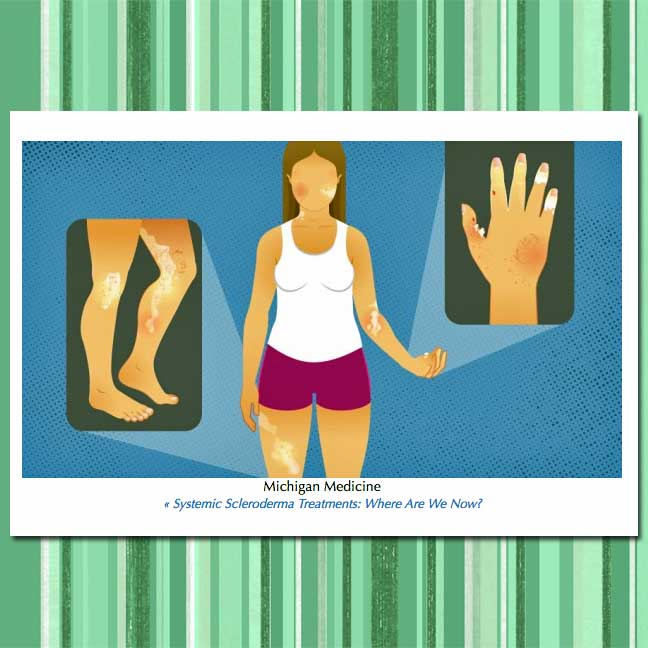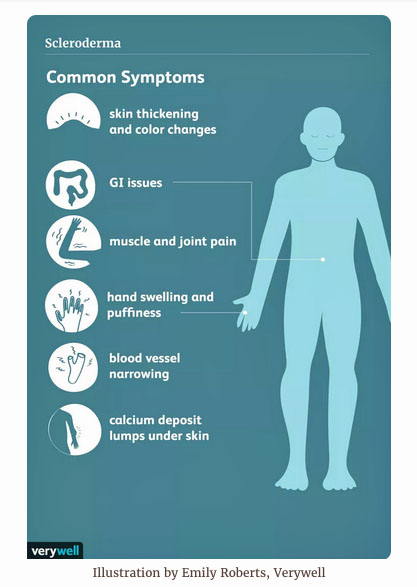Our skin is one of our most important organs of the body. It protects us from so many things. What would you do if you had an autoimmune illness that affects the skin by hardening it and making it tighter? That is exactly what the autoimmune disease Scleroderma does. Scleroderma is a group of rare diseases that hardens and tightens the skin and connective tissues inside and outside of the body.
This affects mostly women between the ages of 30 to 50 years of age. It also affects those who are:
- Native Americans
- African Americans
- Use chemo drugs such as Bleomycin
- Or those who have been exposed to silica dust.
Symptoms of Scleroderma:
- Skin: hardening and tightening that show up as patches of skin that are in shapes of oval or straight lines.
- Fingers and Toes: The early sign is having Raynauds Disease which causes fingers and toes to respond negatively to cold weather by turning blue or purple.
- Esophagus: heartburn and trouble with swallowing.
- Intestines: cramping, diarrhea, and constipation. Also trouble with absorbing nutrients with the intestinal muscles that aren’t working well.
- Heart, Lungs, and Kidneys: As with any other autoimmune disease it attacks the connective tissues around these organs.
- Making too much collagen in the body’s tissues is the cause of Scleroderma.
There are two different types of Scleroderma
- Localized: Morphea or Linear. Morphea is hard oval shaped patches on the skin that are red or purple. Linear are straight streaks or lines of thickened skin on legs, arms, or face.
- Systemic: which affects the inside of the body including intestines and organs.
The treatment includes:
- Nsaids that help with swelling.
- Steroids which help with pain and inflammation.
- Meds to boost blood flow in the body.
- Meds to open up the blood vessels.
- Meds for blood pressure control.
- Meds for heartburn.
- Antibiotics
- Meds to help move nutrients through the intestines.
- Exercise
- Eating more fiber rich foods.
- Drinking plenty of fluids.
- Light and laser treatments for the skin.
- Physical therapy
- Occupational therapy
- Stress management
- Having an organ transplant.
Karen G Clemenson and the Wellness Works NW Team would be happy to guide you through the journey of Scleroderma by having an eating plan and exercise plan. Having a supportive team that works with your medical team and support group helps you achieve your wellness plans and we are willing to do that with you.
Here are some links I would like to share with you:
- Scleroderma Foundation Website
- Living Well with Scleroderma by Lara C. Pullen, PhD for The Rheumatologist
- Scleroderma by American College of Rheumatology Staff
- Scleroderma by Mayo Clinic Staff
- Scleroderma by WebMD Staff
- Image Credit: Symptoms of Scleroderma by Lana Barhum and medically reviewed by Casey Gallagher, MD for VeryWell Health
- Systemic Sclerosis (Scleroderma) by Jaime Herndon and medically reviewed by University of Illinois-Chicago, College of Medicine for HealthLine
- Image Credit: Systemic Scleroderma Treatments: Where Are We Now? by Michigan Medicine – University of Michigan for NewsWise
Related Articles
 Jamie Holloway is a co-owner of Wellness Works NW and she is also our Research Manager and writes our Chasing Wellness with Jamie Holloway and Dear Jamie columns. Jamie is also an Independent Wellness Advocate at dōTERRA. She lives in the Portland, Oregon area. Since October 2011 she has been sharing her Journey Toward Health and Wellness with Vasculitis through her blog at JamieChasesButterflies.com. We hope you are as inspired as we are with the raw candor Jamie uses in her writing. If you would like to help support Jamie’s writing efforts please Donate now.
Jamie Holloway is a co-owner of Wellness Works NW and she is also our Research Manager and writes our Chasing Wellness with Jamie Holloway and Dear Jamie columns. Jamie is also an Independent Wellness Advocate at dōTERRA. She lives in the Portland, Oregon area. Since October 2011 she has been sharing her Journey Toward Health and Wellness with Vasculitis through her blog at JamieChasesButterflies.com. We hope you are as inspired as we are with the raw candor Jamie uses in her writing. If you would like to help support Jamie’s writing efforts please Donate now.














